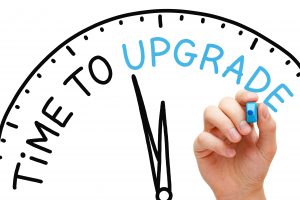A NAV upgrade offers new enhancements and functionality
Everyone knows that being on the latest version of any solution is a good idea – just look at the people who queue up to have the latest smartphone! With Microsoft Dynamics NAV, upgrading means you can take advantage of new enhancements and functionality, and apply these efficiencies to your business. Not only that, if you have a NAV upgrade you will remain within Microsoft’s ˜5 Year Enhancement” period for any patches and bug fixes. However, it takes more than an excited user and fear that something critical may go wrong to justify the spend on services to upgrade. The decision-makers need to see ROI and the value that an upgrade will bring.
But it is all too easy to use that old phrase “if it ain’t broke don’t fix it”, but do nothing and then your version becomes more and more outdated. For any new functionality or changes, you’ll just be adding development to the solution, making it more bespoke and therefore more costly to upgrade.
When do companies upgrade their NAV instance?

Many companies will only consider upgrading when another business policy, goal or issue dictates the need for a NAV upgrade. At that point, you have all hands on deck trying to find the budget and requiring an unrealistic go-live timeframe. The simple truth is that the longer you leave an upgrade, the more it will cost. In an ideal world, all companies would set aside budget every year to upgrade to the latest version, but there are two main options to support different levels of budget and resource availability.
Two NAV upgrade options
A “like for like” upgrade will move you to the latest version, keeping all of your previous customisations and historic data. This requires a low level of customer resource time but won’t necessarily be taking advantage of the new enhancements, new functionality and replacing unrequired customisations. If you have a solution older than five years since release, then this option is quite costly as you are effectively upgrading through each of the versions. However, for those customers who have a recent version of the solution or an “out of the box” solution then a “like for like” upgrade is ideal. You can always consider adding on new functionality set-up at a later date.

The other option is a reimplementation. This makes sense for companies on older versions or those who have a heavily customised version of NAV. You are basically using your current solution as a blueprint to start again from scratch, allowing key stakeholders to review current business processes and map to the latest version. Any customisations not replaced by new standard functionality can still be included and you have the option or importing some years of historic data (but opening balances are recommended). Your historic data will be archived, and is available for access at any time. Whilst being a cleaner and future-proof method, it does require more input and commitment from the customer.
[cta-shortcode id=’6890′]
The choice is yours, but we are here to offer our advice and assistance for both methods of upgrading to the latest version of NAV. There’s more information about upgrading on our website or why not contact us about it today?
Karen Moore – Sales & Account Manager
